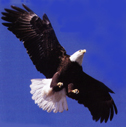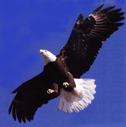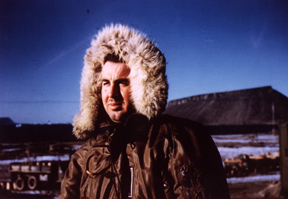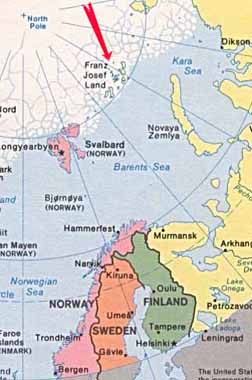|
The Soviet Franz Josef Land Overflight by Page 1 of 1 Page |
||||||||||||
 |
 |
|||||||||||
| On 4 September we made an early morning takeoff for the Thule Air Base. Flying to Thule in loose formation with the C-97, the C-97 flight crew made all our necessary takeoff, en-route and request for landing instructions. As I recall, the C-97 preceded us in landing, with the Thule GCA directing our approach as if we had experienced radio failure. We engaged in no radio communication from the time we first landed at Goose Bay, until we broke radio silence over Thule upon completion of our overflight mission. I believe that this procedure was followed in an attempt to conceal the presence of our RB-50 at Thule. |
||||||||||||
| Upon arrival at Thule, I informed SAC HQ, that we were in place, awaiting an execution order. Everyone had been issued the essential arctic clothing and assigned quarters in a building that resembled a cold storage box. Thule Air Base, on which construction had begun in May 1951, featured only rudimentary facilities still being assembled. Needless to say, we found the temperature quite a change from Puerto Rico. | ||||||||||||
 |
||||||||||||
|
|
||||||||||||
|
While waiting for a break in the weather over Franz Josef Land, we determined that the outside ramp area was not a suitable place to park our aircraft, if we were to maintain it in a constant state of readiness. One solitary black-colored hangar had recently been erected. I decided that such a place was just what I needed. While meeting with the base commander, I suggested that it would be helpful if he could provide us with hangar space. Because he had no knowledge of our project, he declined. I advised him of the importance of our being at Thule, assuming that he had been appraised of the security classification of our mission, and that I received my orders directly from Headquarters Strategic Air Command. I suggested he call the command headquarters. I do not know if he did or not, but he soon advised me that hangar space was being arranged. Our aircraft was soon installed inside the hangar. The base staff was most helpful in providing us with a vehicle and whatever assistance we requested.
Shortly after we arrived, a large number of newspaper and magazine reporters appeared at Thule, flown in by the U.S. Air Force for public relations purposes to showcase this formerly secret base and to present it to the public. Public affairs officers, of course, would have had no knowledge of our preparations for a top secret reconnaissance mission. I soon learned that the civilian reporters were on the base. There were many attempts on the part of the journalists to interrogate our support team and flight crew members. The fact that the reporters were fishing for information created a real concern that the security net surrounding our project would be compromised. The journalists approached our air crew and support team members asking questions. Dining with us at the same time in the mess hall, they inquired: “How long have you been here?” Or, “What is your job here?” etc.: The questions seemed routine enough for the permanent party. We avoided answering them. Our RB-50 being in and out of the hangar for maintenance and preparation purposes, the media people could not help but observe the novel bomber that mounted wing tanks. It was obviously not the usual transport type aircraft. On the day of our overflight mission, taking off in the early morning hours, everyone on the base could hear our engines. Returning after dark, having been gone 14 plus hours, an astute observer could calculate a radius of action and easily compute where we had been. Unknown to us at the time, the reporters were dispatching articles to numerous stateside newspapers and publications highlighting the Thule Air Base. In fact, one of the journalists, (Austin Stevens), with the group, wrote an article that appeared in the “New York Times?”, on 19 September 1952, two days after our mission, in which he opined; “If the Russians have anything comparable, (with Thule) in the way of advanced polar bases, such bases are generally thought to be in the Franz Josef Land group of Islands.” It appears from the various news articles that a press conference was held with the journalists and Base Officials answering questions where, supposedly, unclassified answers were given. |
||||||||||||
| In answer to a direct question, “Was it possible that the Soviets could have a base similar to Thule on the Franz Josef Island of Rudolf?”, the officials declined to answer other than to say that the terrain was suitable for air base construction. Among the numerous published articles, repeated speculation and references were made by the journalists as to the possibility of the Soviets having established a base similar to Thule on the Franz Josef Island of Rudolf. (It seems that the speculation of a Soviet base in the Archipelago was the highlight of their visit, and of their conversation.) |
||||||||||||
 |
||||||||||||
|
The original source for this map 1s found at Internet URL http://chemsrv0.pph.univie.ac.at/ska/fjl.htm You may also learn more by clicking over to this URL For a quick look at a map which reflects the location relationships between Thule, Greenland and Franz Josef Land, click here. Use your back button to return from each of these quick check locations. Related News Notes Austin Stevens, “US Creates Huge Air Base in Far North of Greenland”, New York Times, 19 September 1952, p 1 (Quote at P.5): “Birth of a Base: Now U.S. can be told of the huge effort to build, ‘Blue Jay’, in Northern Greenland”. — Life Magazine, 22 September 1952, pp. 130-151, Without a byline, the account affirmed: “This week the Defense Department gave the public the first detailed announcement of the nations biggest secret military operation since .... the Normandy invasion: The establishment on Greenland, only 900 miles from the North Pole, of a full-scale, year-round base for big bombers ... The Russians are rumored to have set up a counterpart to Thule somewhere in Franz Josef Land” (quote at p. 130). Ed. |
||||||||||||
|
You may go to Cover Page — Editor's Introduction & Prologue — Table of Contents Chapters — 1 — 2 — 3 — 4 — 5 — 6 — 7 Or, you may Home - Contact Us - Cold War Hist. - 91st SRS Hist. - Stardust 40 Mission Story |
||||||||||||